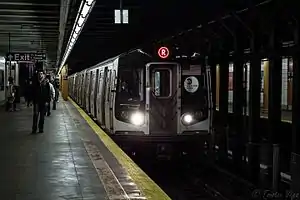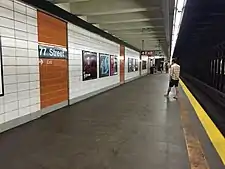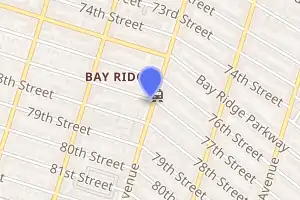77th Street station (BMT Fourth Avenue Line)
77th Street is a station on the BMT Fourth Avenue Line of the New York City Subway. Located at 77th Street and Fourth Avenue in Bay Ridge, Brooklyn, it is served by the R train at all times.
77 Street | ||||||||||||||||||||||||||||||||||||||||||||||||||||||||||||||||||||
|---|---|---|---|---|---|---|---|---|---|---|---|---|---|---|---|---|---|---|---|---|---|---|---|---|---|---|---|---|---|---|---|---|---|---|---|---|---|---|---|---|---|---|---|---|---|---|---|---|---|---|---|---|---|---|---|---|---|---|---|---|---|---|---|---|---|---|---|---|
 Northbound R train arriving at the station | ||||||||||||||||||||||||||||||||||||||||||||||||||||||||||||||||||||
| Station statistics | ||||||||||||||||||||||||||||||||||||||||||||||||||||||||||||||||||||
| Address | 77th Street & Fourth Avenue Brooklyn, NY 11209[1] | |||||||||||||||||||||||||||||||||||||||||||||||||||||||||||||||||||
| Borough | Brooklyn | |||||||||||||||||||||||||||||||||||||||||||||||||||||||||||||||||||
| Locale | Bay Ridge | |||||||||||||||||||||||||||||||||||||||||||||||||||||||||||||||||||
| Coordinates | 40°37′46″N 74°01′33″W | |||||||||||||||||||||||||||||||||||||||||||||||||||||||||||||||||||
| Division | B (BMT) | |||||||||||||||||||||||||||||||||||||||||||||||||||||||||||||||||||
| Line | BMT Fourth Avenue Line | |||||||||||||||||||||||||||||||||||||||||||||||||||||||||||||||||||
| Services | R | |||||||||||||||||||||||||||||||||||||||||||||||||||||||||||||||||||
| Transit | ||||||||||||||||||||||||||||||||||||||||||||||||||||||||||||||||||||
| Structure | Underground | |||||||||||||||||||||||||||||||||||||||||||||||||||||||||||||||||||
| Platforms | 2 side platforms | |||||||||||||||||||||||||||||||||||||||||||||||||||||||||||||||||||
| Tracks | 2 | |||||||||||||||||||||||||||||||||||||||||||||||||||||||||||||||||||
| Other information | ||||||||||||||||||||||||||||||||||||||||||||||||||||||||||||||||||||
| Opened | January 15, 1916[3] | |||||||||||||||||||||||||||||||||||||||||||||||||||||||||||||||||||
| Station code | 037[4] | |||||||||||||||||||||||||||||||||||||||||||||||||||||||||||||||||||
| Accessible | not ADA-accessible; accessibility planned | |||||||||||||||||||||||||||||||||||||||||||||||||||||||||||||||||||
| Opposite- direction transfer | Yes | |||||||||||||||||||||||||||||||||||||||||||||||||||||||||||||||||||
| Traffic | ||||||||||||||||||||||||||||||||||||||||||||||||||||||||||||||||||||
| 2019 | 1,674,582[5] | |||||||||||||||||||||||||||||||||||||||||||||||||||||||||||||||||||
| Rank | 277 out of 424[5] | |||||||||||||||||||||||||||||||||||||||||||||||||||||||||||||||||||
| Station succession | ||||||||||||||||||||||||||||||||||||||||||||||||||||||||||||||||||||
| Next north | Bay Ridge Avenue: R | |||||||||||||||||||||||||||||||||||||||||||||||||||||||||||||||||||
| Next south | 86th Street: R | |||||||||||||||||||||||||||||||||||||||||||||||||||||||||||||||||||
| ||||||||||||||||||||||||||||||||||||||||||||||||||||||||||||||||||||
| ||||||||||||||||||||||||||||||||||||||||||||||||||||||||||||||||||||
| ||||||||||||||||||||||||||||||||||||||||||||||||||||||||||||||||||||
| ||||||||||||||||||||||||||||||||||||||||||||||||||||||||||||||||||||
The 77th Street station was constructed as part of the Fourth Avenue Line, which was approved in 1905 and subsequently modified. Construction on the segment of the line that includes 77th Street started on January 24, 1913, and was completed in 1915. The station opened on January 15, 1916, as part of an extension of the BMT Fourth Avenue Line from 59th Street to 86th Street. The station's platforms were lengthened in 1926–1927 and in 1968-1970.
History

Construction and opening
The 77th Street station was constructed as part of the Fourth Avenue Line. The plan for the line was initially adopted on June 1, 1905, before being approved by the Appellate Division of the Supreme Court of New York on June 18, 1906 after the Rapid Transit Commission was unable to get the necessary consents of property owners along the planned route.[6] The Rapid Transit Commission was succeeded by the New York State Public Service Commission (PSC) on July 1, 1907, and the PSC approved the plan for the line in October and November 1907.[7][8]
As part of negotiations between New York City and the Brooklyn Rapid Transit Company (BRT), and the Interborough Rapid Transit Company for the expansion of the city's transit network, the line was leased to a subsidiary of the BRT. The agreement, known as Contract 4 of the Dual Contracts, was signed on March 19, 1913.[7] In 1912, during the Dual System negotiations, the construction of an extension of the Fourth Avenue subway from 43rd Street to 89th Street, just south of the 86th Street station, was recommended. This recommendation was approved by the Board of Estimate on February 15, 1912. The PSC directed its chief engineer to create plans on June 14, 1912. The two contracts for the extension, Route 11B, were awarded on September 16, 1912, to the Degnon Construction Company for a combined $3.8 million (equivalent to $100.7 million in 2019).[7]
On January 24, 1913, construction began on Route 11B2, which includes this station and extends between 61st Street and 89th Street. Construction was completed on this section in 1915.[6] 77th Street station opened on January 15, 1916, as part of an extension of the BMT Fourth Avenue Line from 59th Street to 86th Street.[3][9]
1920s
On June 27, 1922, the New York State Transit Commission directed its engineers to prepare plans to lengthen the platforms at 23 stations on the lines of the Brooklyn–Manhattan Transit Corporation (BMT), the successor to the BRT, to accommodate eight-car trains. As part of the project, 77th Street's platforms would have been lengthened from 495 feet (151 m) to 530 feet (160 m).[10][11] Progress on the extensions did not occur until February 16, 1925, when the New York City Board of Transportation (NYCBOT) directed its engineers to prepare plans to lengthen the platforms at this and eleven other stations along the Fourth Avenue Line. It estimated the project's cost to be $633,000 (equivalent to $9,228,000 in 2019) (equivalent to $9,228,347 in 2019). The BMT had been ordered by the Transit Commission to lengthen these platforms since September 1923.[12] The NYCBOT received bids for the project on February 25, 1926.[13] The contract was awarded to the Corson Construction Company for $345,021 (equivalent to $4,983,000 in 2019) (equivalent to $4,982,700 in 2019).[14] The extensions opened on August 1, 1927.[15]
1960s
In the 1960s, the New York City Transit Authority (NYCTA) started a project to lengthen station platforms on its lines in Southern Brooklyn to 615 feet (187 m) to accommodate 10-car trains.[16] On July 14, 1967, the NYCTA awarded a contract to conduct test borings at eleven stations on the Fourth Avenue Line, including 77th Street, to the W. M. Walsh Corporation for $6,585 (equivalent to $50,492 in 2019) in preparation of the construction of platform extensions (equivalent to $50,492 in 2019).[17] The NYCTA issued an invitation for bids on the project to extend the platforms at stations along the Fourth Avenue Line between 45th Street station and Bay Ridge–95th Street, including this station, on May 3, 1968.[18]
However, work had already started on the platform extension project in February. As part of the renovation project, the station's platforms were extended at its northern and southern ends, for a total of 85 feet (26 m),[16][19] and the station's elaborate mosaic tile walls were covered over with 8-by-16-inch (20 by 41 cm) white cinderblock tiles. The latter change, which was also made to 15 other stations on the BMT Broadway and Fourth Avenue Line, was criticized for being dehumanizing. The NYCTA spokesman stated that the old tiles were in poor condition and that the change was made to improve the appearance of stations and provide uniformity. Furthermore, it did not consider the old mosaics to have "any great artistic merit".[20]
Station layout
| G | Street level | Exit/entrance |
| B1 | Mezzanine | Fare control, station agent |
| B2 Platform level |
Side platform | |
| Northbound | ← | |
| Southbound | | |
| Side platform | ||
This underground station has two tracks and two side platforms.[21] The R stops here at all times.[22]
While the 95th Street-bound platform has columns along its full length,[23] the Manhattan-bound platform is mostly columnless, with only a few columns located in the middle of the platform and at either end.[24][25][26] The columns on the 95th Street-bound platform are curved, except for those near the staircases to the mezzanine[23] and at the north end of the platform, which are typical I-beams, and are where the platform was extended in 1970.[24] All of the columns are painted yellow and alternate ones have "77 Street" signs on them.[23]
Prior to the station's 1970 renovation, it was finished all in white and marble tile, and it had its own color scheme to allow regular passengers to identify the station based only on the color of the marble trimmings.[7] Since that renovation, the station walls have consisted of white cinderblock tiles, except for small recesses in the walls, which contain orange-painted cinderblock tiles. The blue cinderblock field contains the station-name signs and white text pointing to the exits.[27]
Provisions

The Fourth Avenue Line south of 59th Street, including the Bay Ridge Avenue and 77th Street stations, was built as a two-track structure under the west side of Fourth Avenue with plans for two future tracks on the east side of the street. The station is designed to allow the northbound platform to become the Manhattan-bound express trackway if the two additional tracks were built. To facilitate the conversion, the northbound platform is mostly columnless and is wider than the southbound platform. Furthermore, there is space underneath the platform for the trackway.[21][6][28]
Exits
The station's full-time entrance is a mezzanine at the south end above the platforms and tracks. Two staircases from each platform go up to a waiting area/crossover, where a turnstile bank provides entrance/exit from the system.[26][29][30] Outside fare control, there is a token booth and two staircases going up to either northern corners of 77th Street and Fourth Avenue.[31][32] The northwest staircase has its original ornate banisters and railings.[33][34] Inside the mezzanine, there are mosaics indicating a newsstand and two restrooms, all of which are now closed, and directing to each platform.[35]
In addition, the Bay Ridge-bound platform has an exit-only at the north end, which consisted of one high entry-exit turnstile on the platform.[36] A single platform-level exit-only turnstiles leads to a double flight staircase that goes up to the northwest corner of 76th Street and Fourth Avenue.[31] The landing here has the station's original trim line with "77" tablets on it.[37][38]
References
- "Borough of Brooklyn, New York City". Government of New York City. Retrieved April 16, 2020.
- "Brooklyn Bus Map" (PDF). Metropolitan Transportation Authority. October 2020. Retrieved December 1, 2020.
- "Subway Running To Eighty-Sixth Street Starts Building Boom In Bay Ridge". The Brooklyn Daily Eagle. January 15, 1916. Retrieved June 29, 2015 – via newspapers.com
 .
. - "Station Developers' Information". Metropolitan Transportation Authority. Retrieved June 13, 2017.
- "Facts and Figures: Annual Subway Ridership 2014–2019". Metropolitan Transportation Authority. 2020. Retrieved May 26, 2020.
- Rogoff, David (May 1961). "The Fourth Ave. Subway". New York Division Bulletin. Electric Railroaders' Association: 2–10. Retrieved May 8, 2017.
- Fourth Avenue Subway, Brooklyn's New Transportation Line: A Part of the Dual System of Rapid Transit of the City of New York. New York City: Public Service Commission. June 19, 1915. p. 18 – via HathiTrust.
- "Fourth Avenue Subway Is Sent To A Committee". The Brooklyn Daily Eagle. March 20, 1908. pp. 1–2. Retrieved May 4, 2017 – via newspapers.com
 .
. - Report of the Public Service Commission For The First District of the State of New York For The Year Ending December 31, 1916. Vol. II. Statistics of Transportation Companies For The Year Ending June 30, 1916. New York State Public Service Commission. 1917. p. 136.
- Legislature, New York (State) (1923). Second Annual Report of the Transit Commission (For the Calendar Year 1922). New York State Transit Commission. p. 100.
- Proceedings of the Transit Commission, State of New York Volume III From January 1 to December 31, 1923. New York State Transit Commission. 1923. p. 1277.
- "12 B-M. T. Stations To Be Lengthened". The New York Times. February 17, 1925. ISSN 0362-4331. Retrieved May 4, 2017.
- "Board Receives Platform Bids For B.M.T. Lines. Six Companies Submit Prices for Extending Subway Stations". The Brooklyn Citizen. February 26, 1926. p. 5. Retrieved April 7, 2020 – via newspapers.com
 .
. - "Brooklyn Wins Big Improvement Fund". Brooklyn Standard Union. March 18, 1926. p. 20. Retrieved April 7, 2020 – via newspapers.com
 .
. - "B.M.T. Stations Ready For Eight-Car Trains". Brooklyn Standard Union. August 1, 1927. p. 1. Retrieved April 9, 2020 – via newspapers.com
 .
. - New York City Transit Authority Annual Report For The Year June 30, 1960. New York City Transit Authority. 1960. pp. 16–17.
- Minutes and Proceedings. New York City Transit Authority. 1967. pp. 379–380.
- Engineering News-record. McGraw-Hill. 1968. p. 75.
- Rogoff, Dave (February 1969). "BMT Broadway Subway Platform Extensions" (PDF). New York Division Bulletin. Electric Railroaders' Association. 12 (1): 4.
- Burks, Edward C. (February 21, 1970). "Subways' Colored Tile Gets Cover‐Up Job". The New York Times. ISSN 0362-4331. Retrieved April 7, 2020.
- Dougherty, Peter (2020). Tracks of the New York City Subway 2020 (16th ed.). Dougherty. OCLC 1056711733.
- "R Subway Timetable, Effective November 8, 2020" (PDF). Metropolitan Transportation Authority. Retrieved December 9, 2020.
- Cox, Jeremiah (June 9, 2009). "A low-angle view down the Bay Ridge-bound platform by the staircase up to the mezzanine at 77 Street". subwaynut.com. Retrieved April 17, 2020.
- Cox, Jeremiah (June 9, 2009). "The High Exit Turnstile on the Bay Ridge-bound platform for the exit to 76 Street". subwaynut.com. Retrieved April 17, 2020.
-
- Cox, Jeremiah (June 9, 2009). "Looking down the Bay Ridge-bound side platform at 77 Street, with its round original 1915 columns". subwaynut.com. Retrieved April 17, 2020.
- Cox, Jeremiah (June 9, 2009). "Looking down towards the southern end of the Bay Ridge-bound platform at 77 Street". subwaynut.com. Retrieved April 17, 2020.
- Cox, Jeremiah (June 9, 2009). "Another view across to the Manhattan-bound platform at Bay Ridge with its two staircases down from the mezzanine visible". subwaynut.com. Retrieved April 17, 2020.
- Cox, Jeremiah (June 9, 2009). "A close up of a 77 Street platform sign on the orange cinderblock indentations along the platforms, this one is on the Uptown, Bay Ridge-bound platform between its two exits because the arrow beneath it points towards the exit to 76 St". subwaynut.com. Retrieved April 17, 2020.
- "Brooklyn Subway Extension Plan: Fourth Ave. Line to 86th St., Tunnel to Staten Island, and Eventually a Through Route to Coney Island" (PDF). The New York Times. February 16, 1912. Retrieved June 28, 2015.
- Cox, Jeremiah (June 9, 2009). "One of the two staircases up from the uptown (Bay Ridge-bound) platform at 77 Street to the fully staffed exit". subwaynut.com. Retrieved April 17, 2020.
- Cox, Jeremiah (June 9, 2009). "A wider view of the mezzanine within fare control at 77 Street". subwaynut.com. Retrieved April 17, 2020.
- "MTA Neighborhood Maps: Bay Ridge" (PDF). mta.info. Metropolitan Transportation Authority. 2015. Retrieved August 2, 2015.
- Cox, Jeremiah (June 9, 2009). "Approaching the token booth in the small fare control area to 77 Street". subwaynut.com. Retrieved April 17, 2020.
- Cox, Jeremiah (June 9, 2009). "Approaching the original, ornate 1910s platform entrance to 77 Street". subwaynut.com. Retrieved April 17, 2020.
- Cox, Jeremiah (June 9, 2009). "A close-up of some of the detailing of the ornate 1910s platform entrance to 77 Street". subwaynut.com. Retrieved April 17, 2020.
-
- Cox, Jeremiah (June 9, 2009). "An original Terra-Cotta sign for a long-defunct News Stand with the waiting area sign and bench on the white tiled wall beneath it in the mezzanine area at 77 Street within fare control". subwaynut.com. Retrieved April 17, 2020.
- Cox, Jeremiah (June 9, 2009). "A blacked over terra-cotta sign for Men above an opened gate on the mezzanine at 77 Street". subwaynut.com. Retrieved April 17, 2020.
- Cox, Jeremiah (June 9, 2009). "A Blacked over terra-cotta sign for Women, above a closed bathroom in the small mezzanine area at 77 Street". subwaynut.com. Retrieved April 17, 2020.
- Cox, Jeremiah (June 9, 2009). "A blacked over directional mosaic sign with arrow for the downtown platform on the mezzanine at 77 Street". subwaynut.com. Retrieved April 17, 2020.
- Cox, Jeremiah (June 9, 2009). "A blacked over mosaic arrow sign for Uptown (and the Bay Ridge-bound platform) on the small mezzanine at 77 Street". subwaynut.com. Retrieved April 17, 2020.
- Cox, Jeremiah (June 9, 2009). "The top of the No entry exit only exit from 77 Street at 76 Street". subwaynut.com. Retrieved April 17, 2020.
- Cox, Jeremiah (June 9, 2009). "The staircase up to 76 Street also has original white tiling, the only area still with its trim line is visible in this view, the bottom of the landing outside of fare control from the High Exit Turnstile". subwaynut.com. Retrieved April 17, 2020.
- Cox, Jeremiah (June 9, 2009). "A wider-view of the intact section of platform trim-line at 77 Street at the base of the staircase up from the High Exit Gate exit to 76 Street". subwaynut.com. Retrieved April 17, 2020.
External links
| Wikimedia Commons has media related to 77th Street (BMT Fourth Avenue Line). |
- nycsubway.org – BMT 4th Avenue: 77th Street
- Station Reporter — R Train
- The Subway Nut — 77th Street Pictures
- 77th Street entrance from Google Maps Street View
- 76th Street exit only stairs from Google Maps Street View
- Platforms from Google Maps Street View



